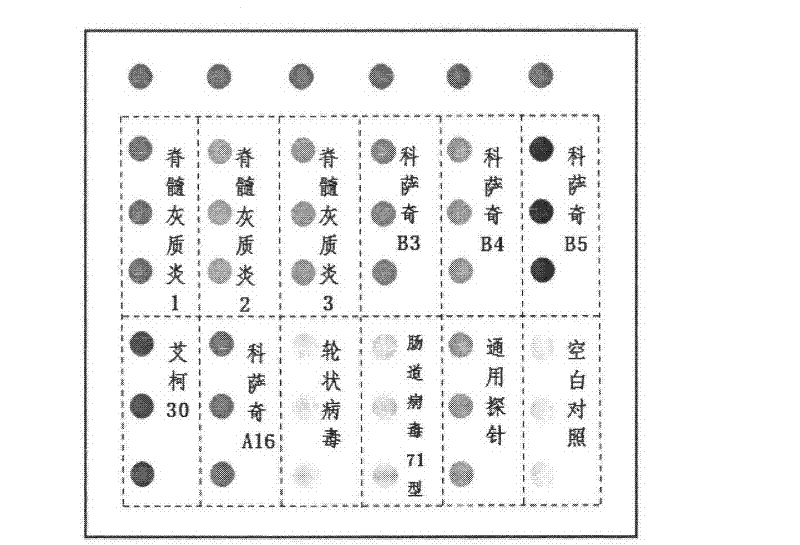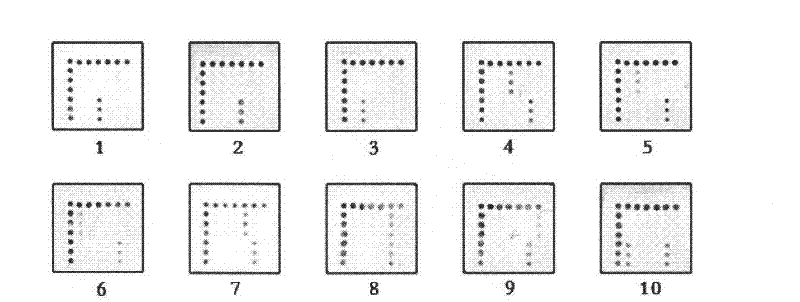Preparation and application of gene chip for detecting important enteric causative viruses
A gene chip and virus technology, applied in the field of gene chip detection, can solve the problems of easy quenching, easy saturation of fluorescent signal, bulky volume, etc., and achieve the effect of good specificity, high specificity and strong practicability
- Summary
- Abstract
- Description
- Claims
- Application Information
AI Technical Summary
Problems solved by technology
Method used
Image
Examples
Embodiment 1
[0046] Example 1: Development of gene chip for visual detection of important enteropathogenic virus nucleic acid
[0047] 1. Specific primer design and screening
[0048] In order to achieve specific amplification of 10 enteropathogenic viruses, 5 pairs of screened specific primers were used to amplify in three-tube multiplex RT-PCR system. The primer sequences and corresponding target virus information are shown in Table 1. The agarose electrophoresis results of the amplified products are shown in the appendix figure 1 , it can be seen from the figure that all 10 enteropathogenic viruses were specifically amplified.
[0049] 2. Screening of specific probes
[0050] The screening of various types of probes first excludes non-specific crossover between the probes and other viruses in the respiratory tract and digestive tract, and then uses RT-PCR products of 10 kinds of viral RNA as templates to hybridize with alternative probes respectively, and investigates the potential of...
Embodiment 2
[0062] Example 2: Determination of Gene Chip Positive Judgment Criteria
[0063] The cutoff value is the standard for judging whether the signal value of the gene chip is positive. Each typing probe selects non-enteroviruses (ie negative strains) and blank controls for gene chip hybridization. Through repeated experiments and data statistics, the negative The background statistical average value +2SD of the virus strain and the blank control was used as the cutoff value of each probe, as shown in Table 6. The discrimination ability of each enteropathogenic virus detection probe is more than 2.5 times as the judgment standard of the virus positive.
[0064] Table 6 Determination of the Cutoff value of each probe
[0065]
Embodiment 3
[0066] Example 3: Specificity evaluation of gene chip for visual detection of important enteropathogenic virus nucleic acid
[0067] Specificity is the most important assessment index of a diagnostic method. The present invention uses optimized systems and conditions to detect 10 strains of various types of common enteroviruses. The chip detection results are shown in the attached image 3 . It can be seen from the figure that the present invention can correctly distinguish 10 common enteroviruses with good specificity.
PUM
 Login to View More
Login to View More Abstract
Description
Claims
Application Information
 Login to View More
Login to View More - R&D
- Intellectual Property
- Life Sciences
- Materials
- Tech Scout
- Unparalleled Data Quality
- Higher Quality Content
- 60% Fewer Hallucinations
Browse by: Latest US Patents, China's latest patents, Technical Efficacy Thesaurus, Application Domain, Technology Topic, Popular Technical Reports.
© 2025 PatSnap. All rights reserved.Legal|Privacy policy|Modern Slavery Act Transparency Statement|Sitemap|About US| Contact US: help@patsnap.com



